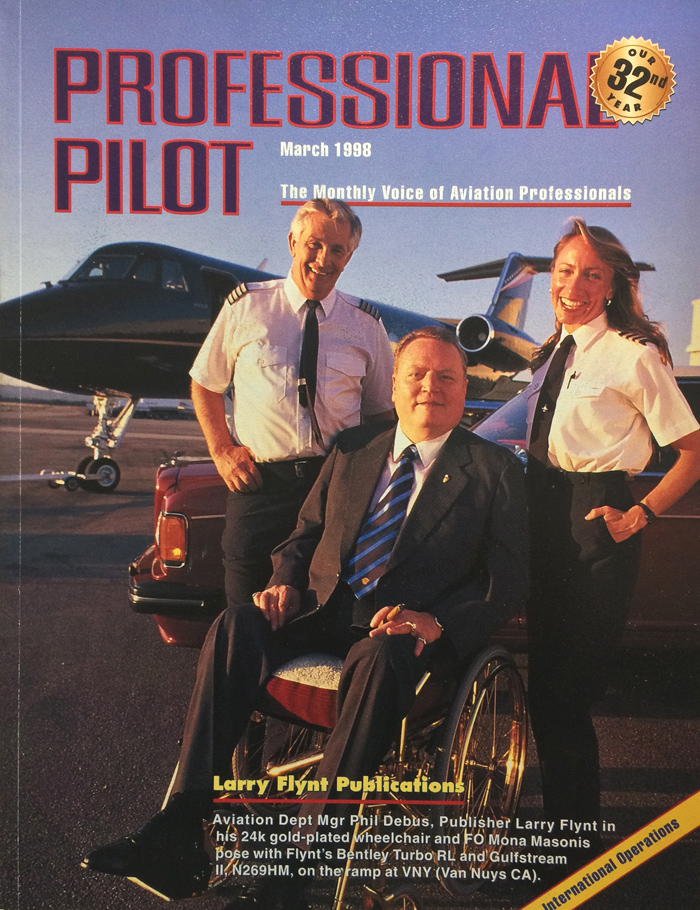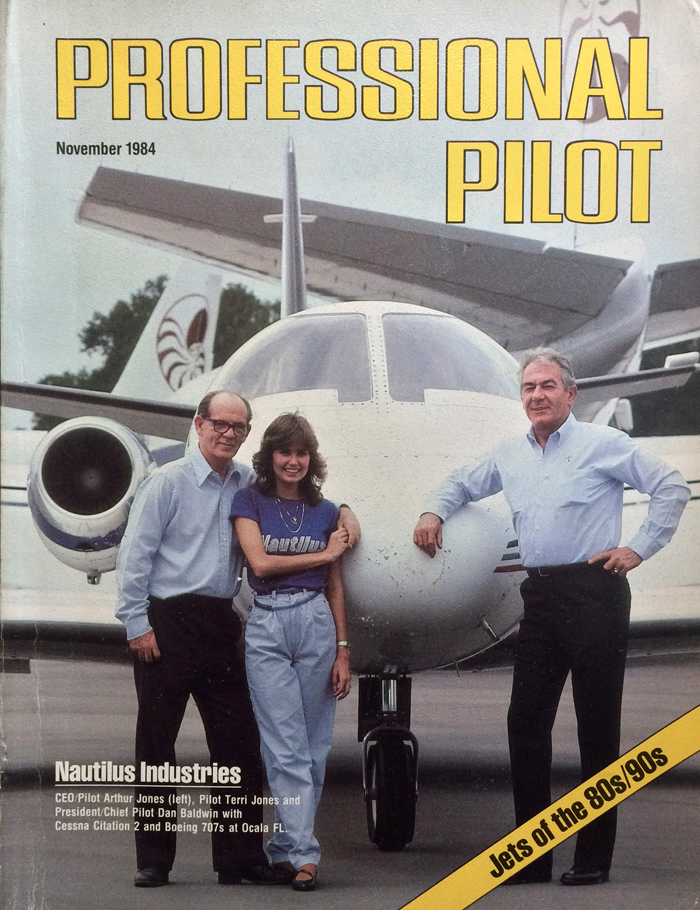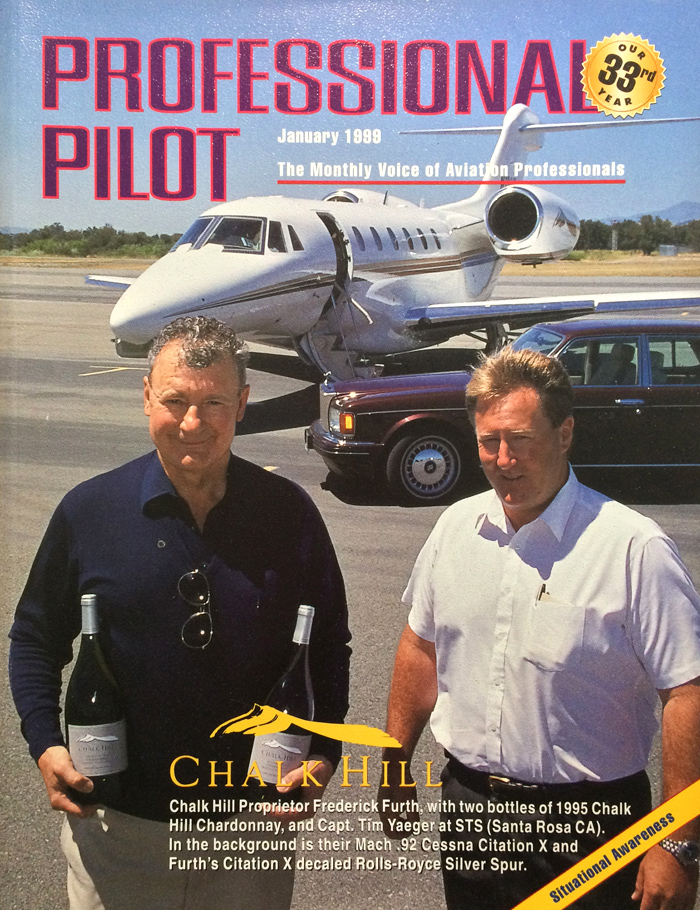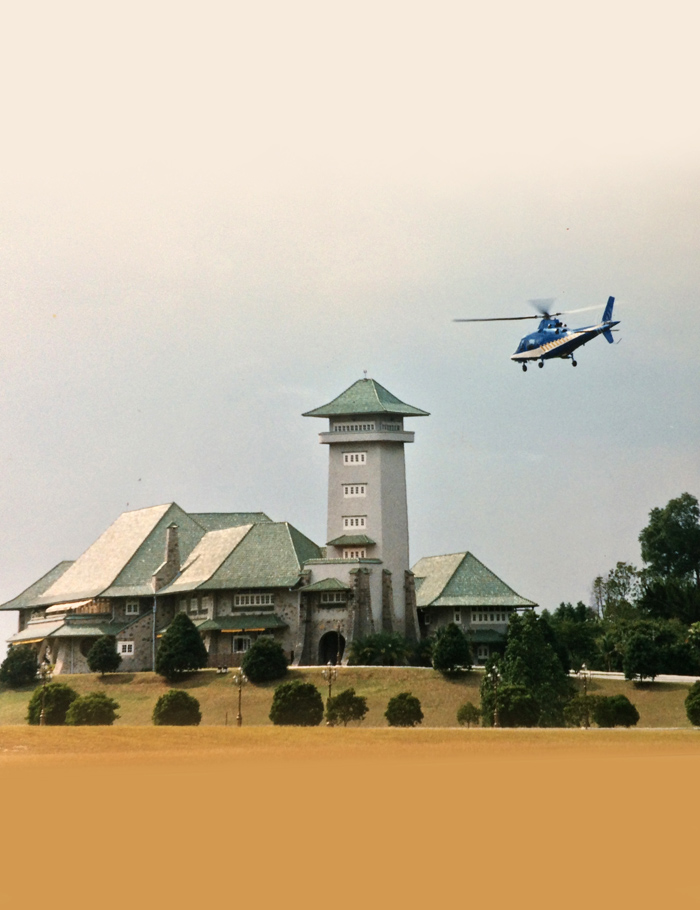Managing a flight department in Malaysia
By Grant McLaren
Professional Pilot Magazine January 1996
“How much do you want for that Falcon?” Tan Sri Ting Pek Khiing asked Dassault representatives during the Langkawi Airshow of December 1993. He was given a list price on the Falcon 900B demonstrator that had brought company executives down to the Malaysian airshow.
“No, you don’t understand — I want your best cash price for taking the airplane with me right now.”
The chairman of Kuala Lumpur-based Ekran Berhad got his Falcon 900B, Serge and Olivier Dassault returned to France by airline and the trijet launched into a 330-day annual travel schedule racking up close to 1000 hours the first year. Managing Capt. James Hanafin together with Captain Pat O’Donahue, who had been operating Ting’s Hawker 800, were dispatched to Falcon school right after the purchase and have scarcely had a day off since.
“Aircraft are our chairman’s basic means of transport. He works all the time, there’s no fixed schedule in his life and we never know where we’ll be flying next,” says Hanafin who has boarded everything on the Falcon from Thai Royal family members to case lots of glass blocks, hinges and bedding required to keep a hotel development on deadline.
Typhoon Ting
Tan Sri Ting, 51, leads a life focused on speed. He’s become famous in Malaysia for building projects in record time and for taking on seemingly impossible tasks. Ting made the Guinness book of records building the 300-room Langkawi Delima resort in just 52 days and the 267-room Sheraton Langkawi in just 100 days. These record times include everything from swimming pool construction right down to landscaping and interior decor details. Ekran’s current projects include a 6000-residence marina development on the Malaysian resort island of Langkawi, a $560 million office plaza in Kuala Lumpur and a $6 billion hydroelectric project in the jungles of Malaysian Borneo slated for completion in just six years. Meanwhile, Ting is busy developing an airport in Bakun Sarawak, complete with a terminal, to support his new regional carrier — Saeaga Airlines — which will operate four Canadair CRJs and four de Havilland Dash 8s by the end of 1996.
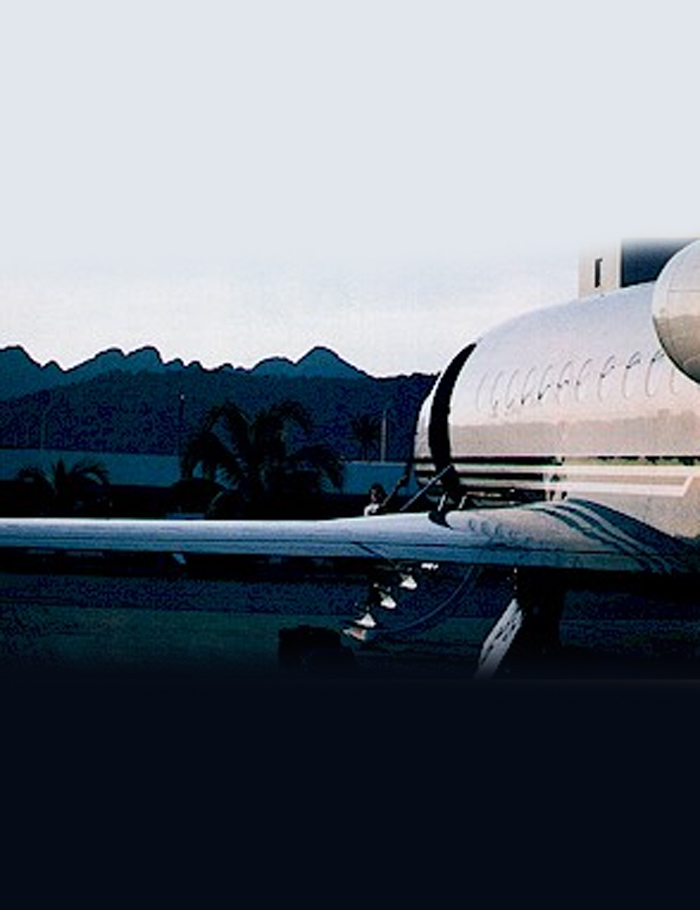 “Wasting time is wasting money,” says Ting. “With a private jet I can keep all my projects on time. It gives me a competitive edge and better control over my businesses. I never have to make the excuse that I can’t attend a meeting and I arrive at my construction sites even before the workers do.”
“Wasting time is wasting money,” says Ting. “With a private jet I can keep all my projects on time. It gives me a competitive edge and better control over my businesses. I never have to make the excuse that I can’t attend a meeting and I arrive at my construction sites even before the workers do.”
Ting runs a 12,000 employee organization in timber, construction, hydroelectric dam building and hotel development. A hands-on tycoon, Ting holds his diverse business empire together with the benefit of corporate jets. While his current Falcon 900B will make London one stop out of Malaysia its real forte is in handling typical 1.1 hour missions within Southeast Asia from fields as short at 4000 ft. Ting lives in Kuching, East Malaysia while many of his business activities and offices are based 600 miles to the west across the South China Sea in Kuala Lumpur. Business jets fit right into Ting’s management.
“If you’re in charge you must exercise hands-on control,” advises Ting. “Staying away and issuing orders from afar while you disappear for two months at a stretch is no recipe for success.”
Ting uses his Falcon 900B as some might use a car. He’ll usually depart at 6 am and make up to eight or nine stops a day visiting construction sites and attending meetings. Pilots here fly a minimum of 70 hours a month, average at least 15 RONs and typically don’t know their schedule from one day to the next.
“After the last stop in the evening he’ll usually tell us where he wants to go at 6 am the next morning,” says Hanafin. “We carry handphones and pagers and we always pack clothes for at least four days. It’s rare to have an entire day off — we’re always on call.”
New Asian flight departments
Tan Sri Ting is an example of a new breed of Asian business leaders who have come to realize the efficiencies and unique advantages of business aviation. As individual wealth in the region blossoms more and more flight departments are being established. This is particularly true in Southeast Asia where governments generally support corporate aviation. They desire the technology involved in the bizjet industry and want to attract maintenance and support facilities to the region. Airports, and airport improvements, bring in maintenance, support and repair activity and give local people technological training.
The Asian Bizjet market is growing steadily, if not quickly, observes Hanafin. With more and more regional investments in Vietnam, China and the developing economies of Africa business people are beginning to appreciate the flexibility and control advantages of operating their own aircraft. A number of Falcon 900s, GVs and Global Expresses have been sold into the region lately while midsized to light corporate jets continue to move well.
Cash price, please
Ting bought his first aircraft, a Hawker 800, at the Langkawi airshow in 1991 and operated it close to 900 hours a year with Hanafin and O’Donahue at the helm. The Hawker flew to Australia, China and Europe and sold its owner on the benefits of corporate aviation. When the Falcon 900B was acquired two years later it offered not only better performance but a more comfortable cabin. Recently, Ting purchased a second Falcon 900B which he leases to a retired government official. “Tan Sri Ting prefers the 900’s proportions,” says Hanafin who, himself, now has the baggage capacity to carry crew golf clubs. At this year’s Langkawi show, December 5 – 10, Ting is considering an upgrade to either a Falcon 900EX, a Gulfstream V or a Global Express.
“He is a man who buys what he likes and he’s used to taking a purchase away with him,” observes Hanafin. “He prefers to pay cash and until a couple of years ago didn’t even have a credit card.”
When Ting walked into a Rolls-Royce dealership in London recently asking, “How much,” a salesman gave him the list price of a basic model. “No, you don’t understand,” said Ting. “I want a cash price for all the cars in the showroom.” A manager quickly appeared and a take-away price was worked out for all seven showroom models. Ting had the vehicles crated and shipped back home to East Malaysia. “Why should I waste time,” says Ting.
Selecting an aircraft
“Now, all the salesmen come to me,” Ting says. “I’ve been happy with my Falcon 900B over the past two years but now I’ll look at the 900EX, the GV and the Global Express and then I will choose.”
A number of aircraft could meet the majority of his mission requirements. “Although a Falcon 2000 would suit most of our missions we often need 14 seats when carrying VIPs who travel with entourages of secretaries and bodyguards,” says Hanafin. “A 900EX would give us the same capacity we have now with the added benefit of getting to altitude faster. At full gross out of Kuching to either Dubai or Tokyo the EX will go straight to FL410 while the 900B will only make FL370 directly. A 900EX, with new Dash 60 engines, would also be cheaper to operate.”
Before Ting strikes a deal on a new aircraft he depends on input from his professional pilots.
“I serve as a go-between and run around in the background between Ting and the manufacturers — we try to give him all the information, operating data and advice he may need,” says Hanafin. “We look at various aircraft types and advise on performance. He’s generally very definite about the price he will pay and sticks to that price. Typically, he will want the aircraft immediately.”
Setting up an Asian flight department
Hanafin envisions strong corporate aviation growth in Southeast Asia — particularly in the area of smaller two-person operations. “That’s the way people like it down here — low key, low profile and very individual. You just get on with the job and if you need someone or something you just try to contract it out.”
Setting up a two-person flight department will cost you between $70,000 and $80,000 (plus accommodation allowances and transport) per ex-pat captain. However, it can be difficult finding type-rated contract pilots to cover a crew on vacations. Attractions for pilots based in this part of Asia include a pleasant living environment, white sand beaches, cheap golf fees and a low cost of living.
Managing an Asian-based flight department has both its challenges and pleasures according to Hanafin. You don’t have the benefit of a US-style FBO network, training facilities are usually far afield and you’ll wait longer for parts. However, once you get south of the slot-controlled Japanese and Hong Kong airports operations are generally less restricted than in either the US or Europe. Flight departments here are typically less formally organized than their Western counterparts.
“You don’t see the type of big-style flight departments profiled in Pro Pilot down here,” says Hanafin. “It’s more typical to operate from a hotel room or out of the trunk of a car — we generally have to be very flexible and able to adapt to last minute flight schedules. Dealing with the authorities around here can be as much an art as a science — everything is less structured. There are no slots and the only speed control in this region is into Singapore — you can basically do what you like within reason.”
O’Donahue observes that managing and running an aircraft is a more self-service affair in Southeast Asia and you have to develop your own local connections. Both pilots keep digital diaries filled with phone and fax numbers of ATC centers and other local contacts.
“The tower tells you were to park and that’s it — you’re on your own. Instead of having a lounge you’re either sitting in the aircraft or running around the airport doing everything yourself.”
Ting’s flight department is a true two-person operation. The Falcon shares hangar space in Kuching with state-owned aircraft. Maintenance is handled out of Singapore by Hawker Pacific Ltd and Universal Weather & Aviation’s Singapore Station Manager, Dave Richards, takes care of most international handling and permit arrangements.
A rigorous schedule
Hanafin and O’Donahue’s flight duty is far from dull and they seldom languish days on end in hotel rooms between flights. With a wide range of destination possibilities within the region the crew may spend one night in a five star hotel in Singapore and the next in cramped and windowless rooms in a remote corner of Malaysian Borneo. Flying internationally within Asia has it’s own particular challenges. “China can still be difficult to operate into, Indonesia is generally OK and Vietnam is developing a great attitude toward corporate aviation,” observes Hanafin.
One recent day for Hanafin and O’Donahue involved six sectors and 10 hours of flying. The crew departed Kuching at 6 am for Miri (45 min) and then to Singapore ( 1 hr 45 min) followed by a stage to Kota Kinabalu ( 2 hrs) and on to Kuala Lumpur (2 hrs). From Kuala Lumpur the crew flew back to Kota Kinabalu in East Malaysia (2 hrs) and then home to Kuching (1 hr 15 min) for a few hours rest before a 6 am departure the next morning to Bangkok.
“We work hard but our chairman works even harder,” says Hanafin. “His typical workday begins at 4 am and often ends at 11pm when the runway closes at Kuching. He’s able to make use the aircraft to relax and recharge his batteries between meetings.”
Both Hanafin and O’Donahue agree that this is a great job if you like to fly and don’t have a family.
“You get the equivalent of five years experience here in less than two years and it’s on a new type of aircraft,” says Hanafin. “It gives you a great resume and as we average 20 takeoffs a week we’re always current.”
Ting’s crew flew 120 hours the first month the Falcon was in service and this dropped to between 90 and 100 hours the following six months. Over the past year 9M-BAN flew 840 hours with just over 700 sectors. The crew carries local Jeps as well as those for the Pacific and China. Trip kits are ordered for all missions further afield and into Europe.
Aircraft ops
All-up costs on the Falcon 900 are running $1650 an hour, according to Hanafin, with an average fuel burn of 2300 lbs an hour over a typical 1.1 hour sector. Range on the Falcon 900B is 10.5 hours and 4100 nm at MTOW. However, even when operating out of a 4000 ft strip the Falcon still features a 4.5- 5 hour range capability. This short field performance gives the Dassault product an edge over other large cabin offerings allowing tankering of fuel on multihop regional missions. One recent flight out of Kuching into Indonesia involved nine hours of flying an six sectors with no enroute requirement to refuel.
In the maintenance arena the five-year-old 900B has been virtually trouble-free. The trijet is on a progressive maintenance program and whenever it overnights in Singapore a portion of an inspection is often accomplished. In two years of operation Ting’s Falcon has been down only eight days for unscheduled maintenance. Hanafin advises that advance maintenance planning is important in the region.
“You end up changing components early to avoid grounding the aircraft later for a number of days,” says Hanafin. “You’ve got to be able to fly every day and it makes it even more challenging when your maintenance base is 400 miles away from home base.”
Ting and his pilots will have plenty of flying to look forward to over the next several years. Ekran Berhard’s chairman plans to continue trading up corporate aircraft every other year at the Langkawi airshow, which is held in the Ekran-built Langkawi convention center. Ting’s idea of the ultimate business transport is to have the first corporate configured Boeing 777 in Asia.
“At first I was in doubt about buying a private jet,” recalls Ting. “But, now I am able to do much more business and I can do things faster.”

